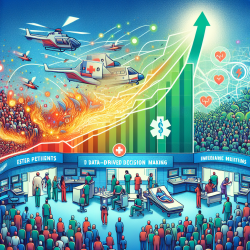Empowering Change: Transforming Emergency Departments for a Brighter Future
In the ever-evolving landscape of healthcare, emergency department (ED) crowding remains a pressing challenge that demands innovative solutions. A recent study titled Effects of process changes on emergency department crowding in a changing world: an interrupted time-series analysis offers valuable insights into how strategic process changes can alleviate this issue. As practitioners dedicated to improving patient outcomes, understanding and implementing these findings can be transformative.
The Power of Process Changes
The study highlights several key interventions that were implemented over a six-year period to address ED crowding. These included the introduction of a general practitioner cooperative (GPC), the expansion of ED capacity, and the addition of medical staff during peak hours. By integrating these changes, the study observed a significant decrease in the modified National ED OverCrowding Score (mNEDOCS) and an improvement in patient flow.
Data-Driven Decisions for Better Outcomes
One of the most compelling aspects of the study is its use of data-driven methodologies, such as interrupted time-series analysis and ARIMA modeling, to evaluate the effectiveness of interventions. This approach allows for a nuanced understanding of how different factors, including external circumstances like the COVID-19 pandemic, impact ED operations. By leveraging data, practitioners can make informed decisions that enhance patient care and operational efficiency.
Key Takeaways for Practitioners
- Expand Capacity Thoughtfully: Increasing the number of ED beds can reduce crowding, but it's essential to ensure that staffing and resources are aligned with this expansion to maintain quality care.
- Integrate General Practitioner Services: Co-locating GPCs with EDs can streamline patient flow by redirecting non-emergency cases, allowing ED staff to focus on more urgent needs.
- Adapt to External Circumstances: The study underscores the importance of flexibility in response to external factors, such as pandemics, which can dramatically alter patient volumes and needs.
Encouraging Further Research
While the study provides a robust framework for improving ED operations, it also highlights the need for ongoing research. Understanding the long-term effects of interventions and exploring new strategies will be crucial in the continuous effort to optimize ED performance. Practitioners are encouraged to engage in research initiatives and collaborate with academic institutions to further this important work.
Conclusion
The fight against ED crowding is an ongoing battle that requires innovative solutions and a commitment to continuous improvement. By embracing data-driven strategies and adapting to changing circumstances, healthcare professionals can create more efficient and patient-centered emergency care environments. For those eager to delve deeper into the research, the original study provides a comprehensive analysis and is a valuable resource for guiding future initiatives.
To read the original research paper, please follow this link: Effects of process changes on emergency department crowding in a changing world: an interrupted time-series analysis.










